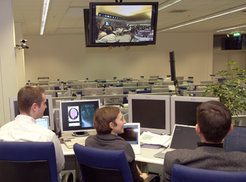Experimenting in Japan from Garching
Remotely controlled plasma experiments / successful preparation for the ITER fusion test reactor

The objective of fusion research is to develop a power plant that, like the sun, produces energy from fusion of atomic nuclei. To ignite the fusion fire the fuel – a hydrogen plasma – has to be confined in magnetic fields without touching the vessel wall and be heated to temperatures of over 100 million degrees.
The preparations for the “remotely controlled” experiments in Japan had already started several days previously. What had otherwise been the task of the physicists at Naka was now handled at IPP in Garching: Here Professor Dr. Hartmut Zohm in conjunction with PhD student Laura Urso, who had acquired a good knowledge of the Japanese experiment during her exchange visit there, had programmed a few plasma discharges for JT-60 Upgrade. The aim was to allow comparison of the JT-60 Upgrade plasma with that of the ASDEX Upgrade experiment at Garching. A particular concern for this purpose was to plan and determine the “time traces” for the various plasma heating systems. Together with specifications for the electric currents in the magnet coils, which decide the configuration of the magnetic cage and hence also the shape of the plasma, it is thus possible to model the course of the entire discharge.
On the experimentation day the physics specifications from Garching were transmitted to Japan from the control room at IPP by internet using a secure high-speed data line. On site at Naka an operator then fed the incoming control data into the computer system of the Japanese device. The IPP physicists could directly assess the plasma discharges thus triggered, in the form of measured curves on their screens, and compare them with their expectations, making corrections for the subsequent discharges. Personal contact with the Japanese team was also maintained by video conferencing. The physicists at Naka and Garching were highly pleased with the result of their joint efforts. Professor Zohm: “Today’s experiment in Japan went off as well as if we had been there on site. This kind of international collaboration will certainly gain in importance in the future.”
Under the terms of a German-Japanese cooperation agreement this “remotely controlled” experimentation served for preparing similar experiments on the ITER (Latin: “the way”) fusion test reactor. The experimental reactor, to be built soon at Cadarache in France, is the next major step in international fusion research. In a cooperation of European, Chinese, Indian, Japanese, Russian, South Korean and US scientists ITER is to demonstrate that an energy-yielding fusion fire under conditions like those in a power plant is possible. To afford all partners optimum use of the device ITER is also envisaged for remote experimentation.
Isabella Milch
